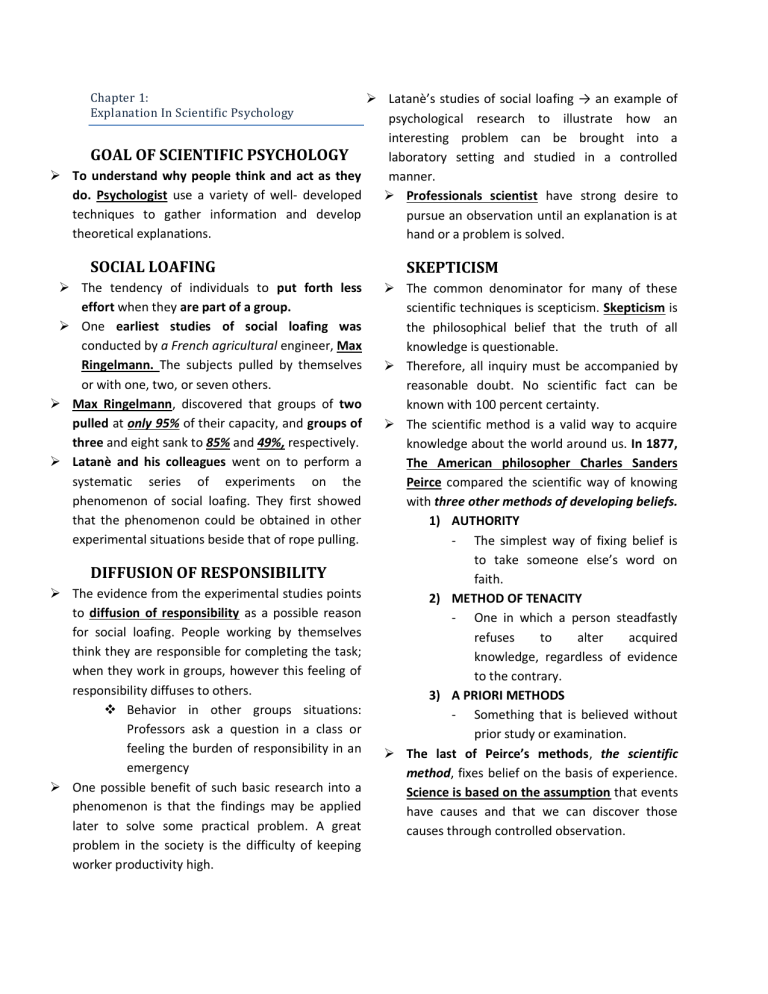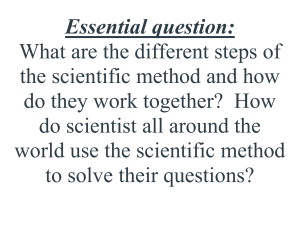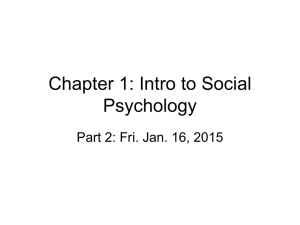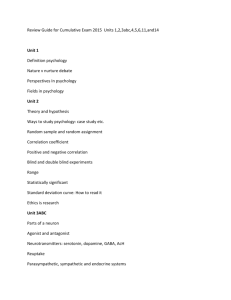
Chapter 1: Explanation In Scientific Psychology ➢ Latanè’s studies of social loafing → an example of psychological research to illustrate how an interesting problem can be brought into a GOAL OF SCIENTIFIC PSYCHOLOGY laboratory setting and studied in a controlled ➢ To understand why people think and act as they manner. do. Psychologist use a variety of well- developed ➢ Professionals scientist have strong desire to techniques to gather information and develop pursue an observation until an explanation is at theoretical explanations. hand or a problem is solved. SOCIAL LOAFING ➢ The tendency of individuals to put forth less effort when they are part of a group. ➢ One earliest studies of social loafing was conducted by a French agricultural engineer, Max Ringelmann. The subjects pulled by themselves or with one, two, or seven others. ➢ Max Ringelmann, discovered that groups of two pulled at only 95% of their capacity, and groups of three and eight sank to 85% and 49%, respectively. ➢ Latanè and his colleagues went on to perform a systematic series of experiments on the phenomenon of social loafing. They first showed that the phenomenon could be obtained in other experimental situations beside that of rope pulling. DIFFUSION OF RESPONSIBILITY ➢ The evidence from the experimental studies points to diffusion of responsibility as a possible reason for social loafing. People working by themselves think they are responsible for completing the task; when they work in groups, however this feeling of responsibility diffuses to others. ❖ Behavior in other groups situations: Professors ask a question in a class or feeling the burden of responsibility in an emergency ➢ One possible benefit of such basic research into a phenomenon is that the findings may be applied later to solve some practical problem. A great problem in the society is the difficulty of keeping worker productivity high. SKEPTICISM ➢ The common denominator for many of these scientific techniques is scepticism. Skepticism is the philosophical belief that the truth of all knowledge is questionable. ➢ Therefore, all inquiry must be accompanied by reasonable doubt. No scientific fact can be known with 100 percent certainty. ➢ The scientific method is a valid way to acquire knowledge about the world around us. In 1877, The American philosopher Charles Sanders Peirce compared the scientific way of knowing with three other methods of developing beliefs. 1) AUTHORITY - The simplest way of fixing belief is to take someone else’s word on faith. 2) METHOD OF TENACITY - One in which a person steadfastly refuses to alter acquired knowledge, regardless of evidence to the contrary. 3) A PRIORI METHODS - Something that is believed without prior study or examination. ➢ The last of Peirce’s methods, the scientific method, fixes belief on the basis of experience. Science is based on the assumption that events have causes and that we can discover those causes through controlled observation. DETERMINISM ➢ The belief that observable causes determine events. ➢ If we define scientific psychology as a repeatable, self-correcting undertaking that seeks to understand phenomena on the basis of empirical observation, then we can see several advantages to the scientific method over the methods just outlined → empirical and self-correcting. WHAT IS A THEORY THEORY ➢ A set of related statements that explains a variety of occurrences. The more the occurrences and the fewer the statements, the better the theory. Theory in psychology performs two major functions: 1) It provides a framework for the systematic and orderly display of data—that is, it serves as a convenient way for the scientist to organize data. (Organization/Description) 2) It allows the scientist to generate predictions for situations in which no data have been obtained. (Prediction/Explanation) ➢ Formulating the roles of theory in this manner often leads to an argument about the relative superiority of deductive or inductive approaches to science ➢ Although F. Bacon recognized the importance of both data and theory, he believed in the primacy of empirical observations; modern scientists also emphasize data and view progress in science as working from data to theory. Such an approach is an example of induction, in which reasoning proceeds from particular data to a general theory. ➢ The converse approach, which emphasizes theory predicting data, is called deduction; here, reasoning proceeds from a general theory to particular data. A THEORY ORGANIZES AND PREDICTS DATA ➢ By means of deduction, particular observations (data) may be predicted. By means of induction, the data suggest organizing principles (theories). This circular relationship indicates that theories are tentative pictues of how data are organized. PURELY INDUCTIVE APPROACH ➢ One problem with a purely inductive approach has to do with the finality of empirical observations ➢ Thus, theories induced from observations are tentative ideas, not final truths, and the theoretical changes that occur as a result of continued empirical work exemplify the selfcorrecting nature of science. ➢ From the standpoint of the deductive approach, scientific understanding means, in part, that a theory will predict that certain kinds of empirical observations should occur. However, since empirical observations are not final and can change, something other than verification may be essential for acceptance or rejection of a theory → falsifiability view. ➢ If a prediction is supported by data, one cannot say that the theory is true. However, if a theory leads to a prediction that is not supported by the data, then Popper would argue that the theory must be false, and it should be rejected. According to Popper, a theory can never be proven; it can only be disproven. FROM THEORY TO HYPOTHESIS A ➢ Theories cannot be tested directly. There is no single magical experiment that will prove a theory to be correct or incorrect. Instead, scientists perform experiments to test hypotheses that are derived from a theory. o A hypothesis is a very specific testable statement that can be evaluated from observable data. o A generalization is a broader statement that cannot be tested directly. SOURCE FOR GENERALIZATIONS ➢ Two sources for generalizations: can come from theory or from experience (common-sense hypotheses). EVALUATIONG THEORIES PARSIMONY ➢ The law of parsimony is a principle that says that the best explanation is the one that requires you to make the fewest possible assumptions about what’s involved. ➢ Correct explanation or solution is usually the simplest. PRECISION ➢ Theories that involve mathematical equations or computer problems are generally more precise. TESTABILITY ➢ This goes beyond precision. The scientist places a very high value on the criterion of testability, because a theory that cannot be tested can never be disproved. Since it is logically possible that some future test may find a flaw, belief in a theory is never absolute. If it is not logically possible to test a theory, it cannot be evaluated; hence, it is useless to the scientist. ABILITY TO FIT DATA ➢ theory must fit the data it explains. While goodness of fit is not a sufficient criterion for accepting a theory, there is little point in pursuing a theory that fails to fit the data INDEPENDENT VARIABLE ➢ variables manipulated experimenter by the DEPENDENT VARIABLE ➢ Variable observed by the experimenter INTERVENING VARIABLE ➢ Abstract concepts that link independent variables to dependent variables o A single intervening variable organizes experimental results sufficiently. • • It is obvious that the indirect method is less complicated. So as science tries to relate more independent and dependent variables, intervening variables become more efficient. There is yet another advantage of intervening variables: it should have the same effect on all dependent variables. PSYCHOLOGY AND THE REAL WORLD ➢ Scientific research is often divided into two categories: basic and applied o Applied research aims at solving a specific problem o Basic research has no immediate practical goal; establishes a reservoir of data, theoretical explanations, and concepts that can be tapped by the applied researcher. ➢ Number of researchers argue that the basic/applied research dichotomy either has been oversimplified or represents a false distinction ➢ For example, definitions of basic and applied research differ considerably among researchers. Furthermore, all scientific research is conducted with the goal of obtaining knowledge. In this sense, all research can be considered basic to some extent. Likewise, most research has some practical value. ➢ For example, the European Journal of Cognitive Psychology (2007) recently dedicated an entire special issue to research on memory in educationally relevant settings. Some of this research may be viewed as basic, in that it tests whether principles of memory discovered using relatively simple laboratory materials (e.g., word lists) hold true for more complex classroomtype materials. ➢ However, it may also be seen as applied, in that the results suggest ways to maximize student learning. Thus, the basic/applied distinction may be better thought of in less discrete terms, or as forming a continuum. CONTEXT: Baliw na kayo sa research – Sen. Cynthia Villar ➢ The data that psychologists gather may at first seem unimportant, because an immediate relationship between basic psychological research and pressing social or personal problems may be difficult to establish. ➢ It is natural then to doubt the importance of certain types of research and to wonder why the federal government, through various agencies, is funding researchers to watch rats press bars or run through mazes. ➢ The physical situations in the real world and the laboratory need not be at all similar, provided that the same processes are occurring. ➢ Laboratory research is concerned with the processes that govern behavior and with showing the conditions under which certain psychological processes can be observed. EXAMPLE: Why do airplane accidents occur or, more specifically, what is the relationship between airplane accidents and failure of attention on the part of the pilot and/or the air traffic controller? Basic research: simple physical situation in a laboratory allows the psychologist to study failure of attention in a carefully controlled environment. Because failures of attention are responsible for many kinds of industrial accidents, studies of attention by use of lights and buttons can lead to improvements outside the laboratory. ➢ We should not only be concerned with the psychological processes that may generalize from the laboratory to an application but also be aware of two important reasons for doing research: o One reason that basic research aids understanding is that it often demonstrates what can happen. o A second reason for the value of basic research is that the findings from a controlled, laboratory setting may have more force than similar findings obtained in a real-life setting. ➢ Of course, if a researcher wants to test a theoretical prediction or apply a laboratory result in an applied setting, then real-life tests will be necessary.



